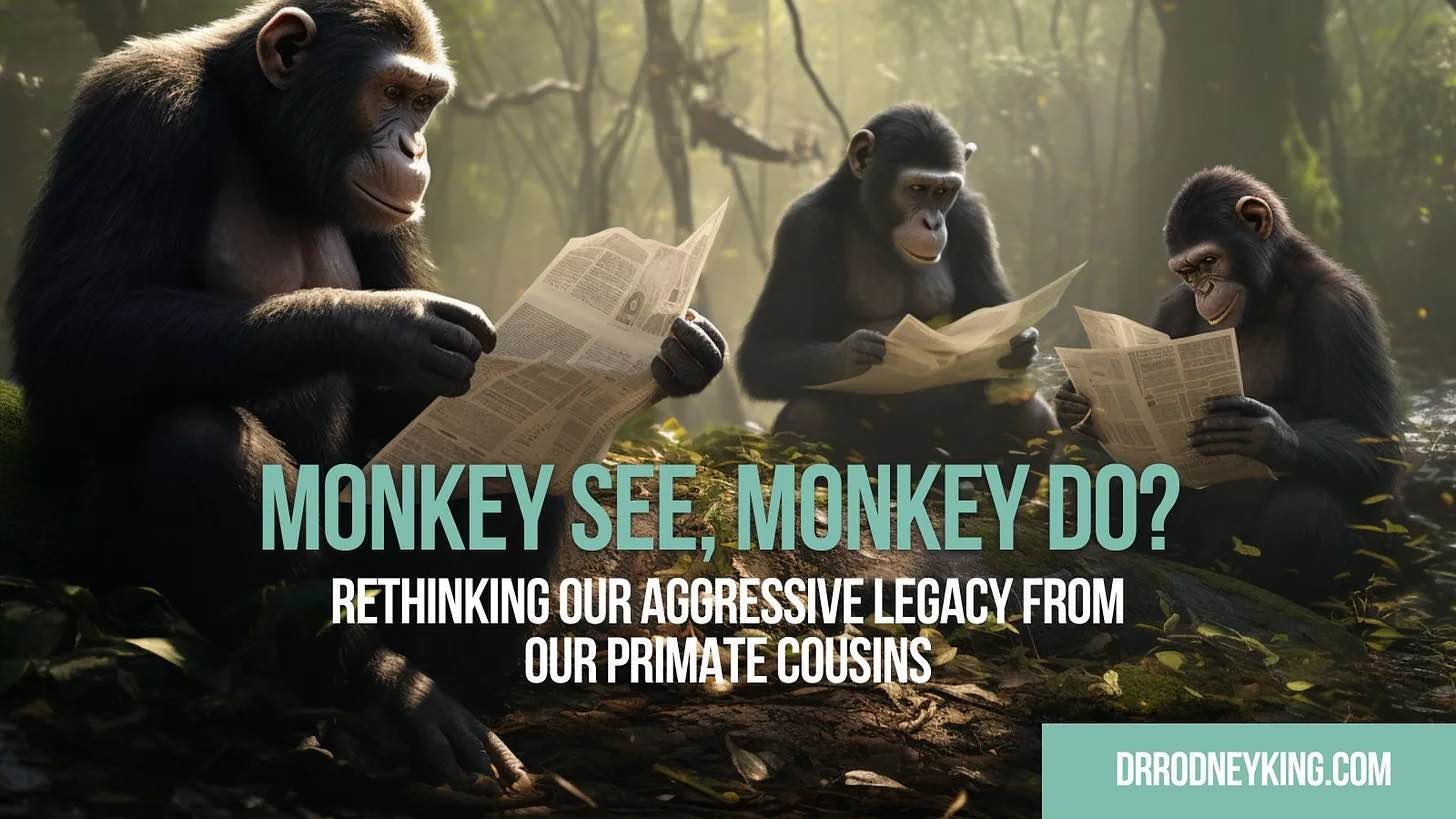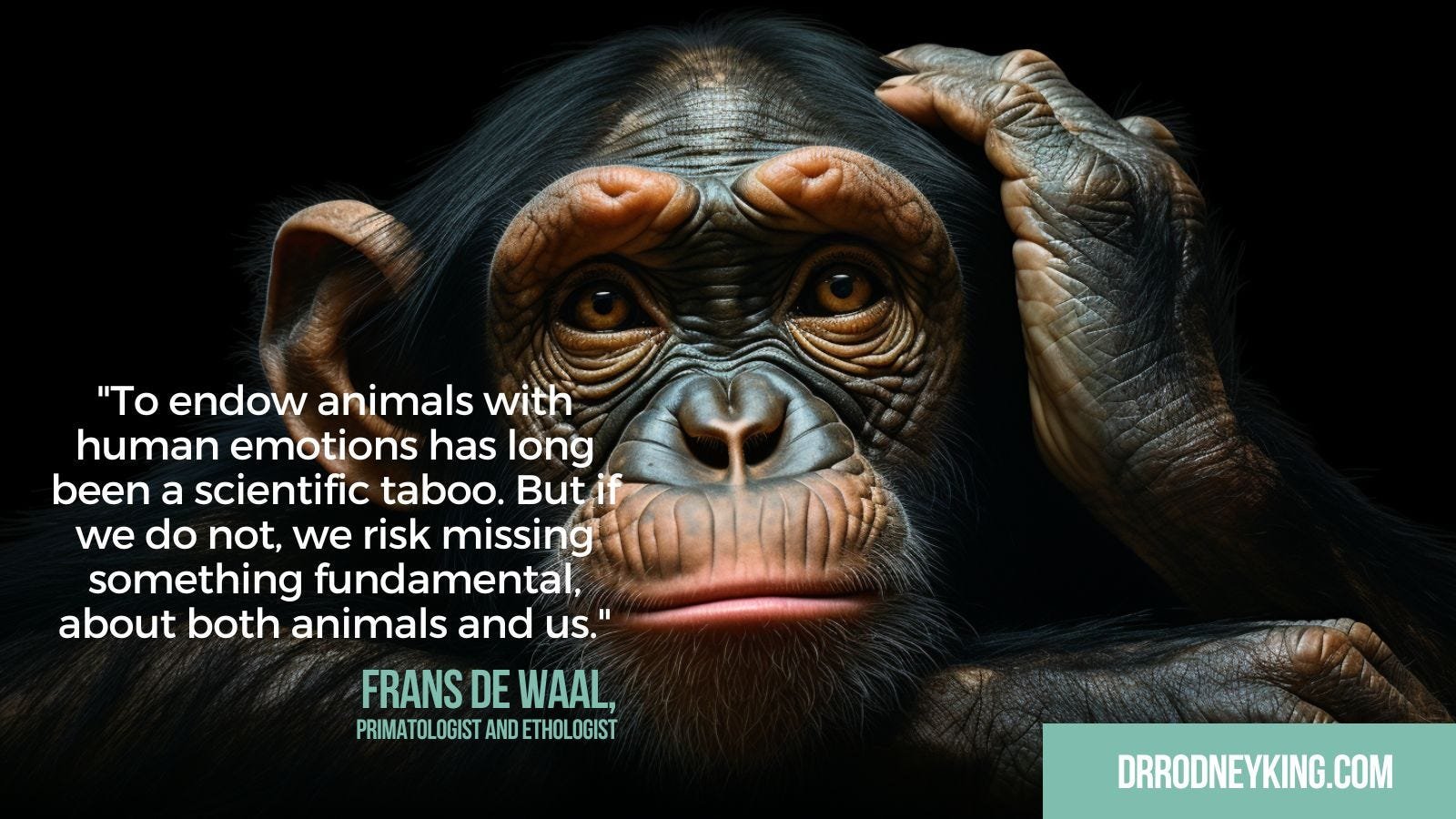Monkey See, Monkey Do?Rethinking Our Aggressive Legacy from Our Primate Cousins
The narrative surrounding chimpanzees (Pan troglodytes) often circles around their proclivity towards violence. This notion, derived from instances of intergroup aggression, is often extrapolated onto humans due to our shared evolutionary roots. However, it is worth questioning whether this aggression is a quintessential characteristic or a behavioural adaptation to environmental stressors (Wrangham, 1999).
The Natural Behavior of Chimpanzees: Society and Interaction
Chimpanzees live in complex social groups that can number in the dozens. Their societies are characterised by strong bonds and interactions based on cooperation, reconciliation, and even empathy, painting a picture far removed from the simplistic narrative of inherent aggression (De Waal, 2000). Observations from long-term field studies show that aggression is not the default mode of interaction but a response to specific conditions or threats.
Instances of violence usually occur during encounters with chimpanzees from other communities, usually over resources, mates, or territorial boundaries. Researchers argue that these acts of violence are not instinctual but context-dependent (Wilson, Hauser & Wrangham, 2001). In other words, aggression is not a default behaviour but a strategic response to potential threats, similar to the defensive aggression observed in many animal species.
Arguably, human interference in chimpanzee habitats has significantly amplified these violent encounters. The widespread encroachment on their natural habitats, primarily due to deforestation and urban expansion, has led to increased competition for dwindling resources, exacerbating intergroup conflict (Pruetz & McGrew, 2001).
Stress and Violence: Understanding the Connection
Chimpanzees, like humans, exhibit signs of psychological and physiological stress when their habitat is threatened (Foerster et al., 2016). Such stressors can promote aggression and violence. Research suggests that violence in chimpanzees, much like in humans, is not an inherent tendency but a response to environmental pressures.
Instead of using instances of violence as an indicator of inherent aggression, it is crucial to understand the broader context. Chimpanzees' behaviour is highly influenced by external stressors, particularly those caused by human activities. By acknowledging this, we can both rectify the false narrative surrounding our closest evolutionary cousins and better comprehend the roots of human aggression.
A Shift in Primate Comparisons
It's common to draw comparisons between humans and our closest relatives, chimpanzees when exploring our species' inherent traits. However, recent research advocates a shift towards our other close relatives, the bonobos (Pan paniscus), to gain a broader and more balanced understanding of human nature (Hare, Wobber, & Wrangham, 2012).
Unlike chimpanzees, bonobos are known for their peaceable, cooperative behaviour and female-dominated societies. They manage conflict largely through sexual behaviours and shared intimacy rather than aggression (Hare et al., 2012). This offers a contrasting, less violent perspective on our natural inclinations, challenging the popular narrative that humans are inherently aggressive.
The case of bonobos and chimpanzees suggests that human behaviour is similarly influenced by environmental factors. Instead of seeing aggression as inherent, it is more accurate and constructive to understand it as a response to pressures and stressors. Like bonobos, we show an incredible capacity for empathy, cooperation, and peacekeeping when circumstances permit (De Waal, 2005).
If we accept that our behaviour is highly adaptable and circumstantial, we can apply these insights to promote a healthier, more cooperative society. Just as bonobos use sexual behaviour and intimacy to foster peace, we can leverage our inherent capacity for empathy, negotiation, and reconciliation to diffuse tension and resolve conflict.
Creating an Environment for Empathy and Cooperation
By reducing stressors such as poverty, inequality, and social exclusion, we can mitigate aggressive behaviours and promote social harmony. By investing in inclusive, equitable policies and social systems, we can nurture a society that favours cooperation over competition, much like bonobos do in their natural habitats (Ryan & Jethá, 2010).
The narrative surrounding human nature and behaviour needs an update. We have as much in common with the peaceable bonobo as with the at-times aggressive chimpanzee. By learning from our primate cousins and applying these lessons to our society, we can foster a world that reflects our capacity for empathy, cooperation, and peace.
References:
De Waal, F. B. M. (2000). Chimpanzee politics: Power and sex among apes. Johns Hopkins University Press.
De Waal, F. B. M. (2005). Our Inner Ape: A Leading Primatologist Explains Why We Are Who We Are. Riverhead Books.
Foerster, S., Cords, M., & Monfort, S. L. (2016). Social behavior, foraging strategies, and fecal glucocorticoids in female blue monkeys (Cercopithecus mitis): Potential fitness benefits of high rank in a forest guenon. American Journal of Primatology, 78(10), 1035–1048.
Hare, B., Wobber, V., & Wrangham, R. (2012). The self-domestication hypothesis: evolution of bonobo psychology is due to selection against aggression. Animal Behaviour, 83(3), 573–585.
Pruetz, J. D., & McGrew, W. C. (2001). What does a chimpanzee need? Using natural behavior to guide the care and management of captive populations. In B. F. M. de Waal (Ed.), Tree of origin: What primate behavior can tell us about human social evolution (pp. 17–48). Harvard University Press.
Ryan, C., & Jethá, C. (2010). Sex at Dawn: How We Mate, Why We Stray, and What It Means for Modern Relationships. Harper.
Wilson, M. L., Hauser, M. D., & Wrangham, R. W. (2001). Does participation in intergroup conflict depend on numerical assessment, range location, or rank for wild chimpanzees? Animal Behaviour, 61(6), 1203–1216.
Wrangham, R. (1999). Evolution of coalitionary killing. Yearbook of Physical Anthropology, 42, 1–30.


